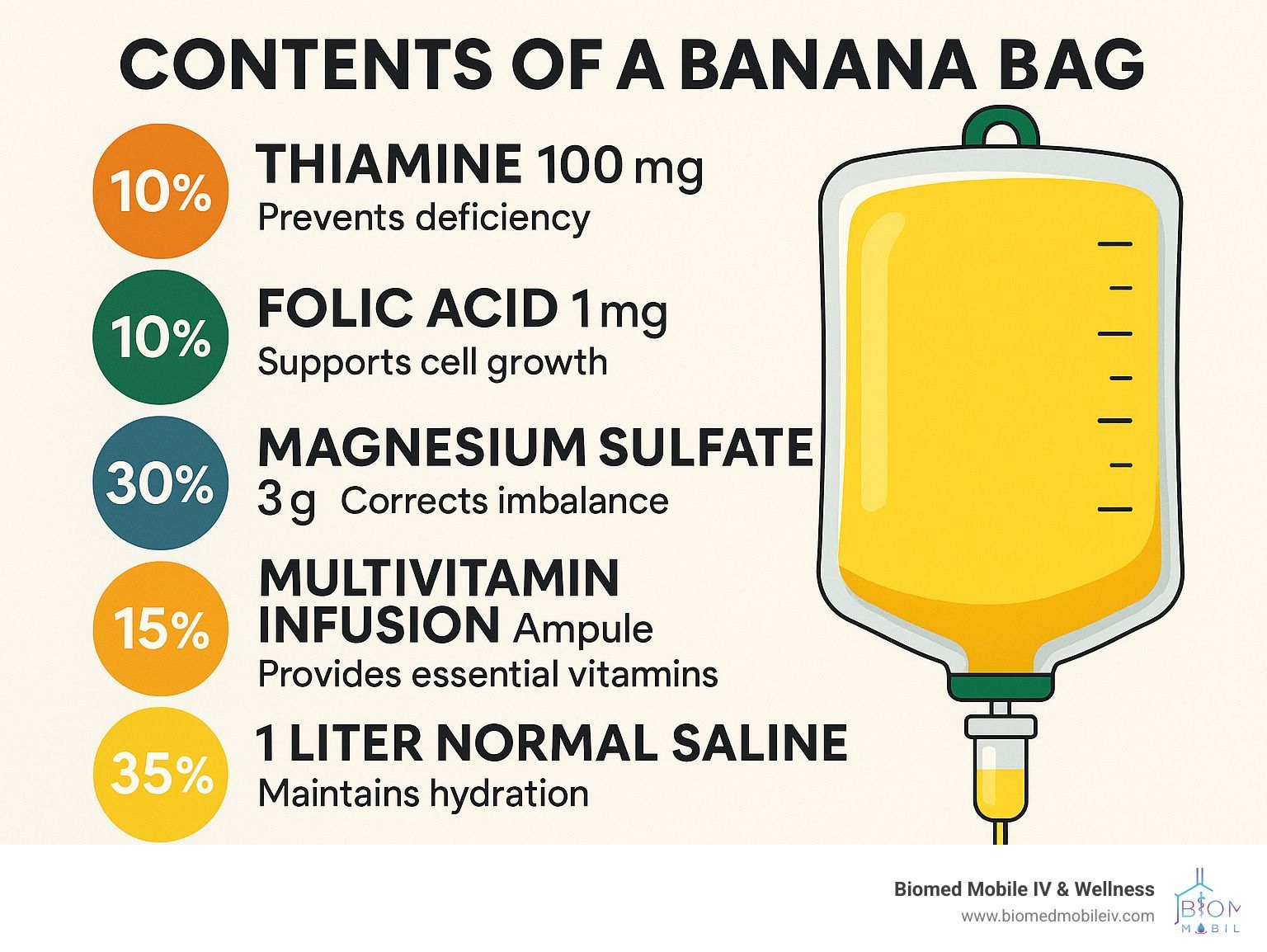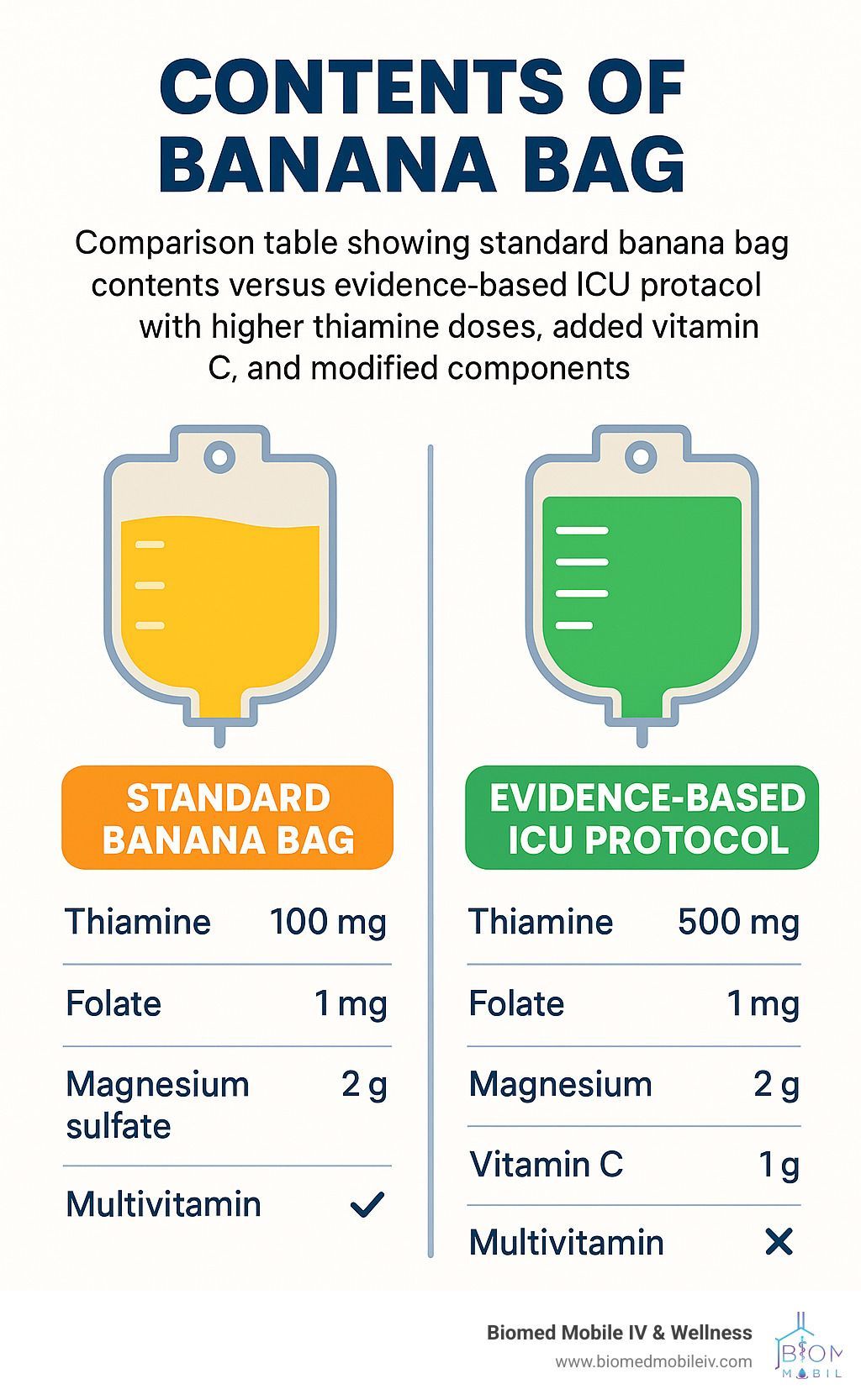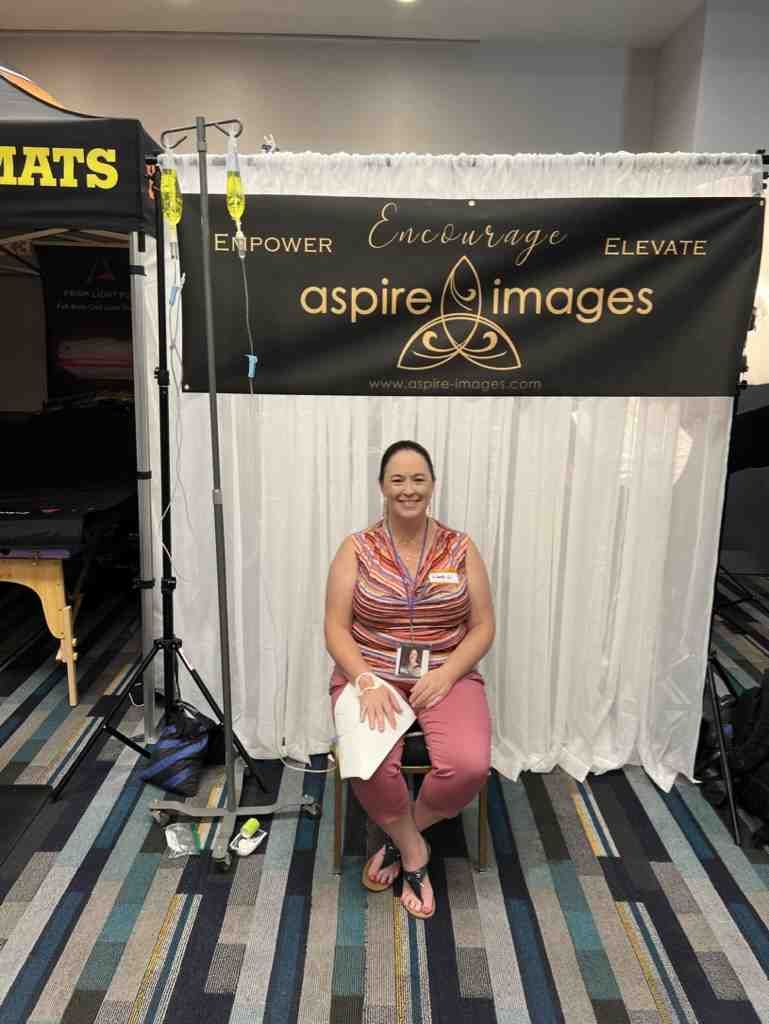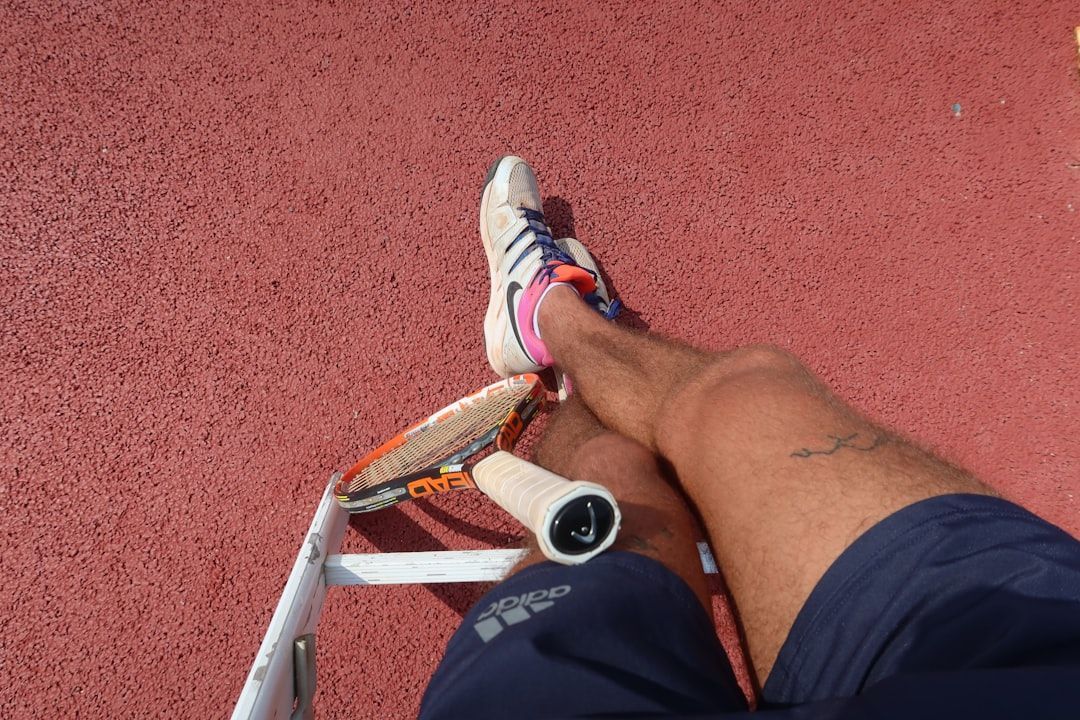Inside the Banana Bag IV – Everything You Need to Know
What's Really Inside a Banana Bag IV?
The contents of banana bag IVs have been a medical staple for decades, but many people don't know what's actually flowing through those distinctively yellow tubes. Here's what you'll typically find:
Standard Banana Bag Contents:
- Thiamine (Vitamin B1): 100 mg
- Folic Acid: 1 mg
- Magnesium Sulfate: 3 grams
- Multivitamin Infusion (MVI): 1 ampule
- Normal Saline: 1 liter base solution
The bright yellow color comes from riboflavin (Vitamin B2) and other B-vitamins in the multivitamin mix - not actual bananas, despite the nickname.
Originally developed for patients with alcohol use disorders and severe nutritional deficiencies, banana bags have evolved into a popular wellness treatment. However, recent medical research suggests the traditional formula may need updating. Some studies indicate the standard 100 mg thiamine dose might be insufficient for critically ill patients, with recommendations now reaching 200-500 mg every eight hours.
The evidence supporting routine use of folate, magnesium, and multivitamins in banana bags is also being questioned. A Cochrane review found no evidence supporting routine magnesium supplementation in alcohol use disorder patients.
I'm Travis Sugg, a paramedic and founder of Biomed Mobile IV & Wellness with over a decade of experience administering IV therapies. Throughout my career, I've seen how understanding the contents of banana bag formulations helps patients make informed decisions about their wellness care.

The Classic Contents of a Banana Bag IV
The traditional banana bag formula hasn't changed much since it was first developed in the 1950s. Understanding each component helps explain why this yellow infusion became such a medical mainstay - and why it might be time for an update.
Ingredient-by-Ingredient Breakdown
Thiamine (100 mg): This B1 vitamin prevents Wernicke's encephalopathy, a serious neurological condition that can occur in patients with alcohol use disorder. Thiamine plays a crucial role in glucose metabolism and nerve function. However, the 100 mg dose was chosen somewhat arbitrarily decades ago, and current research suggests it may be insufficient for many patients.
Folic Acid (1 mg): Essential for DNA synthesis and red blood cell formation, folate deficiency is common in chronic alcohol users. The 1 mg dose provides about 250% of the daily recommended value. Most oral and parenteral multivitamins already contain at least 400 mcg folate, making additional supplementation potentially unnecessary for many patients.
Magnesium Sulfate (3 grams): Magnesium supports over 300 enzymatic reactions and helps with muscle function and heart rhythm. Alcohol increases magnesium excretion, leading to deficiencies. The 3-gram dose aims to rapidly correct these deficits, though evidence for routine supplementation remains limited.
Multivitamin Infusion (1 ampule): Contains various B-vitamins, vitamin C, and other nutrients. Interestingly, there's no strong evidence supporting routine multivitamin use in banana bags for alcoholics. The inclusion appears somewhat arbitrary based on historical practice rather than clinical evidence.
Normal Saline (1 liter): The base fluid provides hydration and serves as the delivery vehicle for vitamins and minerals. Some providers now use Ringer's Lactate instead, which contains additional electrolytes like potassium and calcium.
Why the Yellow Color?
The distinctive banana-yellow hue comes primarily from riboflavin (Vitamin B2) in the multivitamin infusion. Many people mistakenly think potassium creates the color, but it's actually the B-vitamins that give banana bags their signature appearance. This bright color makes the infusion look impressive - though as one researcher noted, "appearance does not equate to efficacy."
The yellow color also serves a practical purpose in hospitals, making it easy for medical staff to quickly identify banana bag infusions among other IV treatments.
Do Banana Bags Work? Reviewing the Evidence
The contents of banana bag IVs have been trusted by medical professionals for over 70 years, but recent research is shaking up everything we thought we knew about this iconic yellow treatment. As someone who's administered countless banana bags in emergency situations, I've seen how they can help patients - but the science behind why they work isn't as clear-cut as we once believed.
The banana bag story begins in the 1950s when doctors needed a quick way to treat severe vitamin deficiencies in patients with alcohol use disorder. Back then, Wernicke's encephalopathy - a devastating brain condition caused by thiamine deficiency - was killing patients who could have been saved with proper vitamin replacement. The banana bag seemed like the perfect solution.
But here's where things get interesting. Recent evidence challenges many assumptions about this widespread practice. An eye-opening autopsy study found that Wernicke's encephalopathy affects about 12.5% of people with chronic alcohol use, yet most cases go completely undiagnosed while patients are alive. This raises a troubling question: are our current treatments actually working, or are we missing something important?
Thiamine Dosing Debate – 100 mg vs 500 mg
The biggest controversy surrounding banana bag effectiveness centers on thiamine dosing. For decades, the standard 100 mg dose seemed adequate - after all, it's what doctors had always used. But modern research tells a different story, and the findings are pretty dramatic.
Current evidence suggests we've been drastically underdosing thiamine. ICU specialists now recommend 200-500 mg of IV thiamine every eight hours for high-risk patients during their first day of treatment. That's potentially 12 times higher than the traditional banana bag dose.
The reason for this massive increase comes down to basic pharmacology that wasn't well understood in the 1950s. Thiamine has a surprisingly short half-life of just 1.5 hours and returns to baseline levels within 6-12 hours. The old once-daily approach simply can't maintain the blood levels needed for optimal brain protection.
Think of it like trying to keep a leaky bucket full with a single cup of water versus a steady stream. The brain needs consistent thiamine levels to prevent neurological damage, especially when patients are receiving IV glucose that rapidly depletes thiamine stores.
Folate, Magnesium & MVI – Hit or Miss?
While thiamine dosing has solid science behind the need for change, the evidence for other contents of banana bag formulations is much shakier. This is where things get uncomfortable for those of us who've been confidently administering these treatments for years.
Folate supplementation through IV appears to offer little advantage over standard oral doses for most patients. The 1 mg dose in banana bags provides about 250% of daily requirements, which sounds impressive until you realize that folate deficiency can typically be corrected just as effectively with oral supplements once patients are stable enough to take them.
Magnesium supplementation has an even weaker evidence base despite widespread belief in its benefits. A comprehensive Cochrane review found no solid evidence supporting routine magnesium supplementation in patients with alcohol use disorder. This challenges the common assumption that magnesium helps with withdrawal symptoms and prevents dangerous heart rhythm problems.
The multivitamin infusion component might be the most questionable of all. There's essentially no evidence supporting routine MVI use in this population, despite it being a standard part of banana bag formulations for decades. The "more vitamins must be better" approach sounds logical but lacks clinical validation.
Emerging Add-Ons: Vitamin C & Trace Elements
Some forward-thinking providers are now experimenting with vitamin C additions to banana bag formulations. Vitamin C deficiency is surprisingly common in people with alcohol use disorders, and while the clinical benefits of IV supplementation remain unclear, the safety profile is excellent and potential benefits include immune support and tissue repair.
Zinc and selenium are also being investigated as potential additions, though these remain experimental and aren't part of standard formulations yet. The idea is appealing - address multiple nutritional deficiencies simultaneously - but we need more research before making these routine additions.
The evidence review reveals an uncomfortable truth: much of what we've assumed about banana bag effectiveness was based on tradition rather than rigorous science. That doesn't mean banana bags are useless, but it does suggest we need to be more thoughtful about when and how we use them.
Updating the Formula: Evidence-Based Dosages & Modern Variations

The gap between traditional banana bag formulations and current medical evidence has become too wide to ignore. Progressive healthcare providers are now updating the contents of banana bag IVs to reflect what research actually shows works best for patients.
The most dramatic change involves thiamine dosing. While the classic formula contains just 100 mg, modern protocols call for much higher amounts. This isn't just a minor adjustment - we're talking about increasing the dose by up to five times what's been standard practice for decades.
Evidence-based formulations also question whether we need all those traditional components. The multivitamin infusion that gives banana bags their signature color? It might be unnecessary for many patients. The magnesium that we've routinely included? Research suggests it's not helping as much as we thought.
High-Dose Thiamine Protocols
The thiamine revolution is perhaps the biggest change in banana bag therapy. Instead of that traditional 100 mg dose, current evidence supports 200-500 mg IV every 8 hours for critically ill patients during their first day of treatment.
This aggressive approach makes sense when you understand thiamine's behavior in the body. The vitamin has a short half-life of just 1.5 hours and returns to baseline levels within 6-12 hours. A single daily dose simply can't maintain the blood levels needed for optimal brain protection.
Septic shock patients and those with severe malnutrition benefit most from these higher doses. The goal is maximizing passive diffusion across the blood-brain barrier to prevent Wernicke's encephalopathy before it starts.
At Biomed Mobile IV & Wellness, we've seen how personalized dosing based on individual patient needs leads to better outcomes than the one-size-fits-all approach of traditional banana bags.
When to Skip or Modify the Bag
Not every patient needs the full banana bag treatment, and sometimes modifications are essential for safety. Renal failure patients face serious risks from the standard 3-gram magnesium dose, which can lead to dangerous hypermagnesemia when kidneys can't properly excrete excess minerals.
Fluid-restricted patients present another challenge. Heart failure patients or those with kidney disease may not tolerate a full liter of normal saline. These patients benefit from concentrated formulations that deliver the same nutrients in smaller volumes.
Pediatric patients require completely different calculations based on weight and age-appropriate formulations. The adult banana bag formula can be dangerous for children, making specialized pediatric protocols essential.
Patients with normal nutritional status often don't need components like multivitamins or folate supplementation. Skipping unnecessary ingredients reduces costs and potential side effects while focusing treatment on what each individual actually needs.
Modern banana bag therapy is moving toward precision medicine - analyzing each patient's specific deficiencies and medical conditions rather than assuming everyone needs the same yellow cocktail that's been used for 70 years.
Oral "Banana Bags" & Other Alternatives

If needles aren't your thing, you're not alone. The growing popularity of oral "banana bag" solutions offers a convenient alternative to traditional IV therapy. These products typically contain similar vitamins and electrolytes found in the contents of banana bag IVs, but in powder or liquid form that you can mix at home.
The appeal is obvious - no medical appointment needed, no needle stick, and a much lower price point. You'll find these oral alternatives marketed as electrolyte powders, hydration sachets, and vitamin-mineral combinations that promise similar benefits to their IV counterparts.
How Oral Solutions Compare to IV
The biggest difference comes down to absorption limitations. Your digestive system can only absorb about 4.5 mg of thiamine from a 30 mg oral dose due to saturable transport mechanisms. It's like trying to pour a gallon of water through a funnel - there's only so much that can get through at once.
IV delivery bypasses these bottlenecks entirely, delivering higher concentrations directly into your bloodstream. This makes a significant difference when you need rapid nutrient replacement or when dealing with severe deficiencies.
Convenience clearly favors oral solutions. You can keep packets in your gym bag, travel kit, or desk drawer. No scheduling, no waiting for a provider, and you can take them anywhere. However, this convenience comes with trade-offs in effectiveness.
During illness, the bioavailability concerns become even more pronounced. When you're nauseous, dehydrated, or dealing with digestive issues, your gut simply can't absorb nutrients efficiently. That's exactly when you need them most, but it's also when oral solutions are least reliable.
Who Should Still Choose IV?
Despite the convenience of oral alternatives, IV therapy remains the gold standard for certain situations. Patients with active vomiting can't keep oral medications down long enough for absorption. Individuals with severe alcohol use disorder often need the rapid, high-dose nutrient replacement that only IV delivery can provide.
Post-operative patients who can't take anything by mouth still need nutritional support. Athletes experiencing heat illness or severe dehydration require immediate fluid and electrolyte replacement that oral solutions simply can't match.
At Biomed Mobile IV & Wellness, we see this frequently throughout the Colorado Front Range. A client in Denver dealing with severe dehydration after altitude sickness, or a Boulder athlete recovering from an intense training session - these situations call for the reliability and speed of IV therapy.
The bottom line? Oral solutions work great for maintenance and mild deficiencies, but when you need serious nutritional support, IV therapy delivers results that oral alternatives simply can't match.
Indications, Contraindications & Myths
After years of administering IV therapies as a paramedic, I've seen how important it is to understand when contents of banana bag IVs truly help patients versus when they're unnecessary or even potentially harmful. Let me share what I've learned about making smart decisions with banana bag therapy.
When a Banana Bag Makes Sense
Alcohol withdrawal represents one of the clearest indications for banana bag therapy. Patients going through withdrawal face real risks of developing Wernicke's encephalopathy, a serious brain condition that thiamine can prevent. The combination of dehydration, poor nutrition, and increased metabolic demands during withdrawal makes IV vitamin replacement both logical and potentially life-saving.
Malabsorption syndromes create another compelling case for IV therapy. When someone has Crohn's disease, gastroparesis, or has undergone certain surgeries, their gut simply can't absorb nutrients effectively. I've worked with patients who couldn't keep oral vitamins down for days - in these situations, bypassing the digestive system entirely makes perfect sense.
Refeeding risk scenarios require careful attention to thiamine replacement. Severely malnourished patients who start eating again can develop dangerous metabolic shifts. Their bodies suddenly need thiamine to process glucose, and without adequate levels, serious complications can occur. The IV route ensures rapid, reliable delivery when it matters most.
At Biomed Mobile IV & Wellness, we've also found that certain athletes experiencing severe dehydration or individuals with chronic autoimmune conditions affecting nutrient absorption benefit significantly from properly formulated banana bag therapy.
Common Misconceptions to Avoid
The instant hangover cure myth might be the biggest misconception I encounter. While banana bags absolutely help with dehydration and can replenish some depleted vitamins, they're not magic bullets for hangovers. Alcohol's toxic effects on the brain, liver inflammation, and sleep disruption take time to resolve regardless of what goes into your IV line.
One-size-fits-all thinking ignores individual patient needs entirely. A 25-year-old athlete who had too much to drink needs very different treatment than a 55-year-old with chronic alcohol use disorder. The standard banana bag formula simply doesn't account for these crucial differences in body weight, kidney function, or underlying health conditions.
The replacement diet fallacy concerns me most as a healthcare provider. I've met people who think regular IV treatments can substitute for proper nutrition. Your body needs fiber, healthy fats, and complex nutrients that only come from real food. IV therapy should improve your health journey, not replace fundamental lifestyle choices.
Throughout Colorado - from Denver to Boulder to Fort Collins - we emphasize that banana bags work best as part of comprehensive wellness plans, not standalone solutions. Understanding these appropriate uses and limitations helps ensure safer, more effective treatment for everyone.
Frequently Asked Questions about the Contents of Banana Bag IV
When patients ask about contents of banana bag IVs, these three questions come up most often in my practice. Let me clear up the confusion with straightforward answers based on current medical evidence.
What makes the bag yellow?
The distinctive banana-yellow color comes from riboflavin (Vitamin B2) and other B-vitamins in the multivitamin infusion - not actual bananas! This bright yellow hue is created when the pharmacy compounds all the vitamins together. Many patients are surprised to learn that potassium doesn't create the color, despite common assumptions.
The yellow appearance actually serves a practical purpose in medical settings. It helps nurses and doctors quickly identify banana bag infusions among other IV treatments, reducing medication errors and improving patient safety.
Are the standard vitamin doses really enough?
This is where modern medicine gets interesting. For thiamine, the answer is probably not. Current research suggests the traditional 100 mg dose falls short for many patients, particularly those who are critically ill or have severe nutritional deficiencies. Evidence now supports 200-500 mg every eight hours for high-risk patients.
However, the folate and multivitamin doses often exceed what's medically necessary. The 1 mg folate dose provides about 250% of daily requirements, and many patients already get adequate vitamins from other sources. This disconnect between evidence and practice highlights why personalized dosing matters more than one-size-fits-all formulations.
The original doses were chosen somewhat arbitrarily in the 1950s, long before we understood vitamin pharmacokinetics and absorption patterns. Modern protocols emphasize tailoring doses to individual patient needs rather than following historical precedent.
Can I replace a banana bag with sports drinks at home?
Sports drinks can definitely help with basic hydration and electrolyte replacement, but they can't match the vitamin concentrations or absorption rates of IV therapy. Think of it like comparing a garden hose to a fire hydrant - both deliver water, but at very different rates and volumes.
For mild dehydration after a workout or a night out, sports drinks work fine. They're convenient, affordable, and readily available. However, when you're dealing with severe deficiencies, persistent vomiting, or can't keep fluids down, IV therapy remains the superior choice.
The key difference lies in bioavailability. Your digestive system can only absorb limited amounts of vitamins at once, especially when you're not feeling well. IV delivery bypasses these limitations entirely, delivering nutrients directly where your body needs them most.
At Biomed Mobile IV & Wellness, we help Colorado Front Range residents understand when home remedies are sufficient versus when professional IV therapy makes the difference. Sometimes a sports drink and rest are perfect - other times, you need the targeted nutrition that only IV therapy can provide.
Conclusion
The contents of banana bag IVs tell a fascinating story of medical evolution. What started as a practical solution for severely malnourished patients in the 1950s has become both a hospital staple and a wellness trend - though not always for the right reasons.
Here's the truth: while these distinctive yellow infusions have genuinely helped countless patients over the decades, clinging to outdated formulations doesn't serve anyone well. The evidence clearly shows we can do much better with personalized, research-backed treatments that actually match what your body needs.
Think about it this way - would you use a smartphone from the 1950s? Medical treatments deserve the same thoughtful updates that we expect from our technology. Modern banana bag contents should reflect current scientific understanding, not decades-old assumptions about vitamin dosing.
At Biomed Mobile IV & Wellness, we've acceptd this evidence-guided approach and bring it directly to your doorstep throughout the Colorado Front Range. Whether you're dealing with a tough hangover in Denver, recovering from altitude sickness in Boulder, or managing chronic fatigue in Fort Collins, our mobile IV therapy services provide convenient access to properly formulated treatments that actually work.
The beauty of mobile IV therapy lies in its flexibility. We can adjust thiamine doses based on your specific risk factors, skip unnecessary multivitamins if you're already well-nourished, or add vitamin C if your immune system needs extra support. It's personalized medicine at its finest - no more one-size-fits-all yellow bags that may or may not meet your actual needs.
Understanding what's really flowing through those IV lines empowers you to make smarter decisions about your health. The future belongs to treatments based on solid science, not medical tradition alone.
For more information about our mobile IV therapy services and evidence-based formulations, contact Biomed Mobile IV & Wellness. We serve communities from Greeley to Castle Rock, bringing safer, smarter hydration care backed by the latest research directly to wherever you need it most.
Because when it comes to your health, you deserve treatments that actually work - not just ones that look impressive in a yellow bag.




